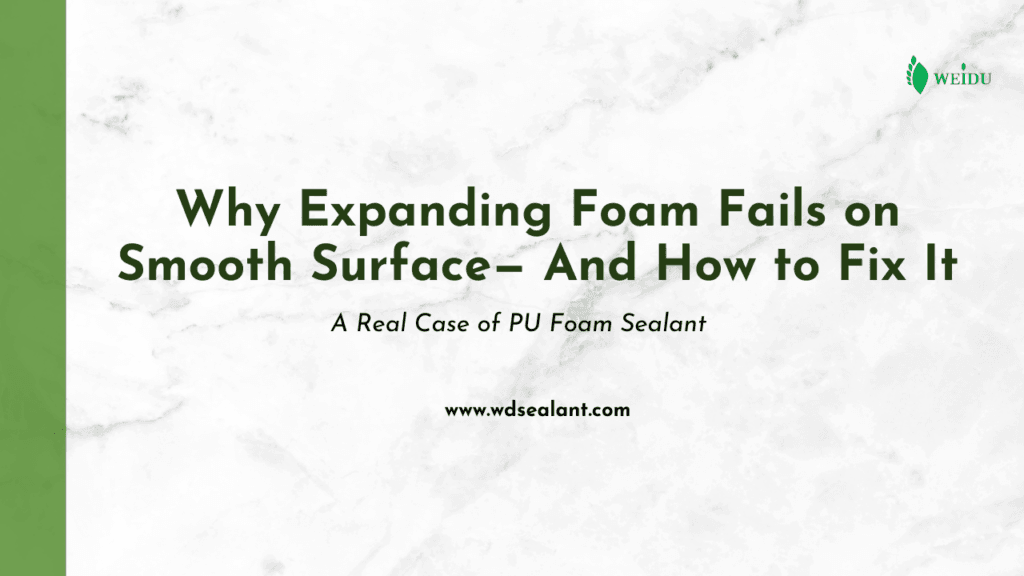This expanding foam application, shared by Janice, comes from a real customer case.
Our client used one-component polyurethane expanding foam (PU foam sealant) to fill the gap between a smooth panel and a wall. However, the moment the foam touched the smooth surface, it slipped off without adhesion. The client felt helpless and turned to us for a solution. After testing, we provided a simple but effective fix: using a foam gun equipped with an atomizing nozzle. This allowed the expanding foam to spread evenly, adhere quickly, and achieve a strong bond.
This case showed us that many consumers may face similar challenges when using foam sealants. As a professional sealant manufacturer, we see it as our responsibility to share the underlying principles and practical solutions to help users better understand and apply expanding foam.
Table of Contents
ToggleHow Expanding Foam Works
Let’s first understand what one-component polyurethane expanding foam is: Expanding foam combines aerosol technology with polyurethane foam chemistry. The main ingredients include: polyurethane prepolymer, catalysts, foaming agents, and propellants. It is packaged in pressurized aerosol cans.
When sprayed, the polyurethane prepolymer reacts quickly with moisture in the air to form a foam structure. Carbon dioxide generated during the reaction makes the material expand, harden, and form an elastic foam with strength.
Thanks to its porous structure, expanding foam provides insulation, soundproofing, and thermal resistance. Its compressive strength and elasticity allow it to withstand external forces and adapt to thermal expansion and contraction of materials, such as in door and window installations. It bonds well with many construction materials, including wood, metal, stone, and plastics.
In terms of application method, foam sealant comes in two main types:
- Straw type: equipped with a plastic straw attached to the can. It is simple to use, suitable for small repairs or filling small gaps.
- Gun type / gun-straw dual type: can be used with a foam gun or directly with a straw. A gun provides better control of dispensing amount and direction, ideal for precise or large-scale applications where pressure control is important.
Case Analysis: Why Expanding Foam Failed on Smooth Surfaces
Our client used one-component polyurethane expanding foam to fill between a smooth board and a wall. The result: the foam slipped off immediately upon contact with the smooth substrate.
It comes down to two adhesion mechanisms:
- Mechanical interlock– the foam penetrates pores and roughness of the substrate, curing like “claws” gripping the surface.
- Molecular interaction – polyurethane prepolymer reacts with active groups on the substrate surface, forming attraction forces that bond foam to the base material.
However, some smooth materials have extremely low surface energy and lack pores or roughness. It’s like a layer of invisible ice where adhesive molecules cannot grip, resulting in failure to bond.
Solution: How to Bond Expanding Foam on Smooth Substrates
After repeated testing, Weidu Sealant found a practical solution: using a foam gun with an atomizing nozzle. This allows the expanding foam to adhere quickly and firmly to smooth substrates.
The construction principle includes: Cleaning and lightly sanding the surface to create micro-scratches; spplying primer where necessary to improve adhesion; and spraying with an atomizing nozzle to achieve even coverage.
Step-by-step process we used:
- Prepare a can of expanding foam with a professional gun and fan-shaped nozzle. Spray a light mist of water onto the surface first to accelerate curing.
- Shake the can well, then operate with the can upside down.
- Keep the gun nozzle 20–30 cm from the substrate.
- Spray slowly in mist form, ensuring an even thin layer covers the smooth surface.
This atomized spray increases surface wetting, improves initial tack, and ensures the foam expands and bonds securely after curing.
Key Application Tips for Different Substrates
Different materials require different handling methods:
- Glass or glazed tiles: very smooth, low friction. Lightly sand the surface so cured foam can anchor mechanically.
- Oily metal or wood with release agents: clean with alcohol or degreaser to remove oil and release layers before foaming.
- Polished marble (very dry, dense surface): spray a light mist of water before applying foam to aid curing.
Low-surface-energy plastics (chemically inert): apply a primer first, then use a gun with atomizing nozzle, or select foam specially formulated for plastics.
How to Choose a Quality Expanding Foam
Construction method is only half of success. The other half depends on product quality. Even with correct use, poor-quality foam may lead to weak adhesion, shrinkage, or coarse bubbles.
Key indicators of a good foam sealant include:
- Strong adhesion – poor foam will sag in vertical gaps and fail to bond properly.
- High expansion yield – quality foam expands more, saving cost.
- Fine, uniform cell structure – ensures stability; poor foam has coarse, powdery cells.
- Good elasticity – quality foam recovers under pressure; inferior foam crushes easily.
- Low shrinkage – all foam shrinks, especially in hot and dry conditions. Quality foam shrinks less, ensuring precise installation.
Product Recommendation: Weidu WD-A1 Expanding Foam
WD-A1 Expanding Foam (PU Foam Sealant) provides:
- Fast curing – shortens waiting time and improves efficiency.
- Strong bonding – stable elasticity and adhesion from -10℃ to 80℃.
- Uniform cell structure – reduces heat loss and improves insulation.
- Eco-friendly formula – 0 formaldehyde, no harmful emissions, safe for indoor use.
- Excellent durability – resistant to UV, moisture, and weathering, ensuring long service life.
- High strength – supports up to 400 lbs, suitable for heavy-duty door and window installation.
This case proves that with the right construction method and a reliable expanding foam product, users can achieve excellent sealing and bonding results.
Contact us for more professional advice on application techniques!
Janice
Application Engineer at Weidu Sealant, with years of experience in expanding foam training and construction guidance. Dedicated to providing efficient and reliable sealing and bonding solutions for users.

